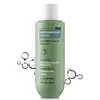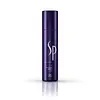What's inside
What's inside
 Key Ingredients
Key Ingredients

 Benefits
Benefits

 Concerns
Concerns

 Ingredients Side-by-side
Ingredients Side-by-side

Water
Skin ConditioningSodium Lauroyl Methyl Isethionate
CleansingCocamidopropyl Betaine
CleansingPropanediol
SolventDimethiconol
EmollientGlycerin
HumectantTea-Dodecylbenzenesulfonate
CleansingAcrylates Copolymer
Parfum
MaskingPiroctone Olamine
PreservativeSalicylic Acid
MaskingEpilobium Angustifolium Extract
Skin ConditioningPanthenol
Skin ConditioningRosmarinus Officinalis Leaf Extract
AntimicrobialNasturtium Officinale Extract
PerfumingSalvia Officinalis Leaf Extract
CleansingNiacin
SmoothingBiotin
AntiseborrhoeicAloe Barbadensis Leaf Extract
EmollientMenthol
MaskingMilk Protein
Skin ConditioningStearamidopropyl Dimethylamine
EmulsifyingGlycol Stearate
EmollientGuar Hydroxypropyltrimonium Chloride
Skin ConditioningMica
Cosmetic ColorantTitanium Dioxide
Cosmetic ColorantTin Oxide
AbrasivePEG-45m
HumectantSodium Chloride
MaskingCitric Acid
BufferingPhenoxyethanol
PreservativeSodium Benzoate
MaskingDisodium EDTA
Water, Sodium Lauroyl Methyl Isethionate, Cocamidopropyl Betaine, Propanediol, Dimethiconol, Glycerin, Tea-Dodecylbenzenesulfonate, Acrylates Copolymer, Parfum, Piroctone Olamine, Salicylic Acid, Epilobium Angustifolium Extract, Panthenol, Rosmarinus Officinalis Leaf Extract, Nasturtium Officinale Extract, Salvia Officinalis Leaf Extract, Niacin, Biotin, Aloe Barbadensis Leaf Extract, Menthol, Milk Protein, Stearamidopropyl Dimethylamine, Glycol Stearate, Guar Hydroxypropyltrimonium Chloride, Mica, Titanium Dioxide, Tin Oxide, PEG-45m, Sodium Chloride, Citric Acid, Phenoxyethanol, Sodium Benzoate, Disodium EDTA
Water
Skin ConditioningDimethicone
EmollientVp/Va Copolymer
Propylene Glycol
HumectantAminomethyl Propanol
BufferingCarbomer
Emulsion StabilisingEthyl Ester Of Pvm/Ma Copolymer
Alcohol Denat.
AntimicrobialPolyquaternium-4
PEG-40 Hydrogenated Castor Oil
EmulsifyingBenzyl Alcohol
PerfumingTocopheryl Acetate
AntioxidantMethylparaben
PreservativeParfum
MaskingHydroxyethylcellulose
Emulsion StabilisingDisodium EDTA
Linalool
PerfumingBenzyl Salicylate
PerfumingLimonene
PerfumingHexyl Cinnamal
PerfumingAlpha-Isomethyl Ionone
PerfumingWater, Dimethicone, Vp/Va Copolymer, Propylene Glycol, Aminomethyl Propanol, Carbomer, Ethyl Ester Of Pvm/Ma Copolymer, Alcohol Denat., Polyquaternium-4, PEG-40 Hydrogenated Castor Oil, Benzyl Alcohol, Tocopheryl Acetate, Methylparaben, Parfum, Hydroxyethylcellulose, Disodium EDTA, Linalool, Benzyl Salicylate, Limonene, Hexyl Cinnamal, Alpha-Isomethyl Ionone
Ingredients Explained
These ingredients are found in both products.
Ingredients higher up in an ingredient list are typically present in a larger amount.
Disodium EDTA plays a role in making products more stable by aiding other preservatives.
It is a chelating agent, meaning it neutralizes metal ions that may be found in a product.
Disodium EDTA is a salt of edetic acid and is found to be safe in cosmetic ingredients.
Learn more about Disodium EDTAParfum is a catch-all term for an ingredient or more that is used to give a scent to products.
Also called "fragrance", this ingredient can be a blend of hundreds of chemicals or plant oils. This means every product with "fragrance" or "parfum" in the ingredients list is a different mixture.
For instance, Habanolide is a proprietary trade name for a specific aroma chemical. When used as a fragrance ingredient in cosmetics, most aroma chemicals fall under the broad labeling category of “FRAGRANCE” or “PARFUM” according to EU and US regulations.
The term 'parfum' or 'fragrance' is not regulated in many countries. In many cases, it is up to the brand to define this term.
For instance, many brands choose to label themselves as "fragrance-free" because they are not using synthetic fragrances. However, their products may still contain ingredients such as essential oils that are considered a fragrance by INCI standards.
One example is Calendula flower extract. Calendula is an essential oil that still imparts a scent or 'fragrance'.
Depending on the blend, the ingredients in the mixture can cause allergies and sensitivities on the skin. Some ingredients that are known EU allergens include linalool and citronellol.
Parfum can also be used to mask or cover an unpleasant scent.
The bottom line is: not all fragrances/parfum/ingredients are created equally. If you are worried about fragrances, we recommend taking a closer look at an ingredient. And of course, we always recommend speaking with a professional.
Learn more about ParfumWater. It's the most common cosmetic ingredient of all. You'll usually see it at the top of ingredient lists, meaning that it makes up the largest part of the product.
So why is it so popular? Water most often acts as a solvent - this means that it helps dissolve other ingredients into the formulation.
You'll also recognize water as that liquid we all need to stay alive. If you see this, drink a glass of water. Stay hydrated!
Learn more about Water